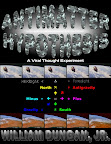Here's a NASA video from space shuttle mission STS-80. You need to click on it twice to view it at YouTube. This video was recorded on a space shuttle mission that launched 19 November 1996. Earth is in the background. The flashes are lightning. A luminous object enters from the lower right hand corner, decelerates, hovers above cloud level, and then becomes geostationary. This object appears to obey hypothetical laws of antigravity.
Be advised that the space shuttle was designed with nineteen seventies technology. So the black and white video camera has a video tube, not a CCD chip like modern cameras. The black center to lightning is an artifact of video tubes when intense saturation occurs over an extended area of the image. Notice that the object takes on a dark center when it decelerates completely.
This is the same characteristic video tube artifact as lightning, which means that the object became brighter when it halted its downward momentum. That’s a clue, but a clue to what? When a meteor streaks across the sky it leaves a trail, as it disintegrates. Notice that this object leaves no trail, but it is bright. Something must cause that brightness. Either reflection of the sun, or an innate capacity to generate electromagnetic radiation. The operational altitude of the space shuttle was about 350 kilometers for this mission. Meteors burn up between fifty and eighty-five kilometers above the Earth's surface. This object is farther away than the distance from Seattle to Portland and is either very bright or very big. Maybe both. Maybe not. Size is inconclusive, like the luminosity of stars at night.
Earth’s edge becomes obvious toward the end of the video. A narrow band lies in night, which means the sun could be reflecting off the object. Are natural objects highly reflective? The Moon is.
A chemical reaction between the object and Earth’s atmosphere might cause an increase in brightness, but that should leave a trail. Reflective objects can be bright without leaving trails. Maybe the trail exists, but any evidence appears outside the visible spectrum. That would make antimatter an intriguing possibility.
Here is the same footage converted to a negative image, so the object appears black instead of white.
E = mc2
The equivalence of mass and energy is described by Einstein’s famous equation: energy equals mass times the speed of light squared. Experiments with particle accelerators confirm that the conversion of energy into substance always produces a pair of matter-antimatter particles. The Milky Way is formed out of matter; so where is all the antimatter hiding? The particle and antiparticle of pair production exhibit opposite properties of electric charge, and magnetic moment. Maybe particles of matter and antimatter exhibit opposite properties of gravitation too.Antimatter with antigravity properties might explain this phenomenon, but be cautioned that explaining a phenomenon may or may not be the same thing as causing it. Antigravity explains deceleration in Earth’s gravity for one, and antimatter explains increased brightness in Earth’s atmosphere for another. Matter and antimatter in contact annihilate each other and produce gamma rays. Gamma rays are outside the visual spectrum and outside the range of the space shuttle video camera, but gamma rays are ionizing radiation. That means gamma rays strip electrons from atoms and molecules. The result is a localized aurora effect around the object.
Whereas a normal meteor quickly disintegrates, antimatter in Earth’s atmosphere would transform into primary gamma radiation, and secondary ionization effects. The first annihilations occur between electrons and their antiparticle, positrons, leaving positive ions in Earth’s atmosphere. Electron movement to neutralize this initial imbalance of electric charge might cause lightning, which we observe.
In Earth’s atmosphere, matter-antimatter annihilations would dissolve antimatter as if by acid. Imagine an Alka-Seltzer tablet being dropped into a glass of water. The tablet fizzed away, and slowly dissolved from the outside in. The rate of annihilation depends on the density of the antimatter and atmospheric pressure. A chunk of asteroid would dissolve slow and steady, whereas a chunk of comet would dissolve faster but exhibit erratic movements due to out gassing, a motion suggestive of the flight characteristics described by reports of unidentified flying objects. In addition, no debris remains at crash sites, which explains another bugaboo. A melting snowball comet would produce antigravity droplets and vapor. Air fuel mixture is a factor in the rate of combustion. Ball lightning, which exhibits antigravity properties, is consistent with a small antimatter comet.
Another object appears and travels to the upper left of the image, parallel to the path of the original object. Either this new object is coming up out of the clouds or down from above. Recall that the first object decelerated and hovered before acquiring the rotation of the Earth. Antimatter on a collision course with the Earth hitting the atmosphere could explain all of these observations. When the object first appears there is a bloom of light, and the object decelerates as it moves. Any other explanation needs to account for both those facts, and the distance to the object is hundreds of kilometers.









No comments:
Post a Comment